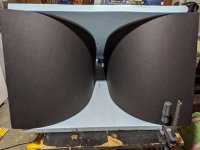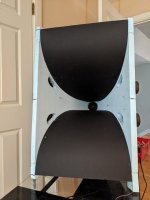Recently I've found myself feeling the need for some more sensitive speakers. I remember building a pair of these out of random materials a while ago 
I think it's time to do it properly, and with foam core! One question I did have before restarting the project was, and I apologise for not going through this thread thoroughly, is there a design of the original Trynergy where it can be built as a fully-enclosed box, yet still takes into account the 9 or 11 litre chamber required for the polycone woofers?
I think it's time to do it properly, and with foam core! One question I did have before restarting the project was, and I apologise for not going through this thread thoroughly, is there a design of the original Trynergy where it can be built as a fully-enclosed box, yet still takes into account the 9 or 11 litre chamber required for the polycone woofers?
I've started on the next set of Trynergy speakers, and given that I'm making a pair it took a fair amount of time to score the concave sides of the tractrix profile. If you have a steady hand, I'd say freehand it...because the last panel I did was about 3 times faster than the first, which I did with a straight edge 
@xrk971: I don't appear to have enough Foam Core for the top and bottom, but I have plenty of 1" XPS foam that I can recycle from another project. Given its thickness, is this OK 'as-is' for the woofer ports, or should I remove some in those areas (in and around the speaker mount location)?
I mocked it up, and it looked like it could be quite nice - kind of a 60s/70s look:
@xrk971: I don't appear to have enough Foam Core for the top and bottom, but I have plenty of 1" XPS foam that I can recycle from another project. Given its thickness, is this OK 'as-is' for the woofer ports, or should I remove some in those areas (in and around the speaker mount location)?
I mocked it up, and it looked like it could be quite nice - kind of a 60s/70s look:
Attachments
Last edited:
that looks really good and the color combo reminiscent of Acoustic Control
https://i.imgur.com/TdTn1hD.png
https://i.imgur.com/TdTn1hD.png
I've been hacking away, and made some progress! I've got the drivers mounted (very sloppily (for now), ports cut (I'm glad I made that template on post #264!).
I've wired them together into a single 8 ohm speaker without any DSP, so it's not ideal, but I had to play some music through it. First, It's pretty cool that this is a full-range enclosure..depending on your listening environment a sub isn't strictly necessary. It somehow makes this large horn more unassuming, if that makes sense.
Lots of midrange and vocal intelligibility (I'm using the 6.5" polycone woofers and a FaitalPRO 3FE25). Fun stuff, and a relatively quick build even though the XPS foam was a bit of a pain to work with.
This led me to thinking about paper mache...something that I haven't done for a long time, so I might make a mold for the tractrix shape and see where things go! The side-effect of that would be an increasingly cleaner house
I've wired them together into a single 8 ohm speaker without any DSP, so it's not ideal, but I had to play some music through it. First, It's pretty cool that this is a full-range enclosure..depending on your listening environment a sub isn't strictly necessary. It somehow makes this large horn more unassuming, if that makes sense.
Lots of midrange and vocal intelligibility (I'm using the 6.5" polycone woofers and a FaitalPRO 3FE25). Fun stuff, and a relatively quick build even though the XPS foam was a bit of a pain to work with.
This led me to thinking about paper mache...something that I haven't done for a long time, so I might make a mold for the tractrix shape and see where things go! The side-effect of that would be an increasingly cleaner house
I believe I've made a mistake with this build. Going back into the history of the thread, I noted that the ports were meant to be 3 inches from the mouth of the horn.
However, at the time, I believe we were referring to the 0.70x version of the build. The current build is the full-size horn, so I'm guessing that they should be around 4.28 inches from the mouth. Is that correct?
However, at the time, I believe we were referring to the 0.70x version of the build. The current build is the full-size horn, so I'm guessing that they should be around 4.28 inches from the mouth. Is that correct?
Attachments
If you have DSP it’s not a big deal as you can adjust the delays. If doing passive XO, a simulation would be best to determine the ideal location. But there are formulas for estimating where it should be to get time alignment. Look in some of the synergy threads for the details. It can only be estimated because ultimately it is also a function of the small chamber formed by the driver cone and where the voice coil it located relative to the horn wall. But you are fine if using DSP. Your build looks great, btw. Good luck!
Thanks X, and thanks for the explanation on the port locations. I'm definitely going to take the papier mache route, as we can turn it into a project I do with the kids  Time to get the shredder out and scavenge discarded paper and cardboard!
Time to get the shredder out and scavenge discarded paper and cardboard!
I'll be using DSP for the crossovers and time delay considerations at this point - less soldering for me to mess up
I'll be using DSP for the crossovers and time delay considerations at this point - less soldering for me to mess up
Hi there, I’ve been thinking a lot about full range drivers loaded in WAW multi entry horns recently and I believe this is one of the best threads I’ve found regarding the topic.
From my understanding the biggest issue with this design idea is the connection of the full ranger driver to the horn?
The other design elements are actually relatively straight forward from that point?
I was considering whether a 3D printed standardised MEH horn could be designed that has an “easily” changeable mounting end for the full ranger than can be designed in CAD which has a sleeve fit onto the main body of the horn with some bolt mounts (external to the horn) that holds it in place, probably with a small gasket.
Therefore you could design and print new end mounts for the differing full range options and have a standard horn with “standard” woofers that it can be interchanged in to.
I can get the CAD work done, I don’t have the audio science really to develop the right interface between full range driver and horn mouth. Would anyone be interested in working on this collaboratively?
From my understanding the biggest issue with this design idea is the connection of the full ranger driver to the horn?
The other design elements are actually relatively straight forward from that point?
I was considering whether a 3D printed standardised MEH horn could be designed that has an “easily” changeable mounting end for the full ranger than can be designed in CAD which has a sleeve fit onto the main body of the horn with some bolt mounts (external to the horn) that holds it in place, probably with a small gasket.
Therefore you could design and print new end mounts for the differing full range options and have a standard horn with “standard” woofers that it can be interchanged in to.
I can get the CAD work done, I don’t have the audio science really to develop the right interface between full range driver and horn mouth. Would anyone be interested in working on this collaboratively?
Thanks for your interest.
Good idea! I’m all for it.
There is another thread where I created a 3D printed adapter for a 2.5in full range and commercial tractrix horn.
https://www.diyaudio.com/community/threads/a-bookshelf-multi-way-point-source-horn.285030/



Good idea! I’m all for it.
There is another thread where I created a 3D printed adapter for a 2.5in full range and commercial tractrix horn.
https://www.diyaudio.com/community/threads/a-bookshelf-multi-way-point-source-horn.285030/
@bonjonno sent me some photos of his Micro Trynergy speakers, which he finally got painted black. He’s been listening to them for a year now and very happy with them. The do look great in black vs white and pink foam. 
Thanks for sharing Bonjonno!
Are you using the passive XO or is this an active speaker?


Thanks for sharing Bonjonno!
Are you using the passive XO or is this an active speaker?
Correction, @bonjonno said the speakers were built in 2020 and usede blue XPS foam with black paper-faced foam core. But all black looks and sounds better anyhow,  This implementation is using four 6.5in Parts Express polycone blowout woofers and a 2in Typmphany fullrange driver. Amps are 3e TPA3255 Class D amps and a miniDSP.
This implementation is using four 6.5in Parts Express polycone blowout woofers and a 2in Typmphany fullrange driver. Amps are 3e TPA3255 Class D amps and a miniDSP.

Hey,
here seems to be a nice and helpful community and i want to built my first diy speaker for my pretty small and narrow room.
im very interested in the approach of geddes and toole and in regards of that i have some questions if building these speakers is even that worth.
right know i have following setup and room:

Toole says that a good speaker has even dispersion and lateral reflections are desirable while early reflections are less desirable.
So i was thinking of building 4 Trynergy speakers (supported by 4 subs with steep xover @ around 120hz [SwarmSubs by Geddes]) while one pair is firing at me and 2 are rotated by 90 degrees facing inwards the room like this:

regarding this i have few questions:
here seems to be a nice and helpful community and i want to built my first diy speaker for my pretty small and narrow room.
im very interested in the approach of geddes and toole and in regards of that i have some questions if building these speakers is even that worth.
right know i have following setup and room:
- Revel M16 Front
- Yamaha YST SW 160
- Lyngdorf TDAI 1120 with RoomPerfect
Toole says that a good speaker has even dispersion and lateral reflections are desirable while early reflections are less desirable.
So i was thinking of building 4 Trynergy speakers (supported by 4 subs with steep xover @ around 120hz [SwarmSubs by Geddes]) while one pair is firing at me and 2 are rotated by 90 degrees facing inwards the room like this:
regarding this i have few questions:
- does this work?
- how big do the speakers have to be (if i use subs crossed over this high)
- is the dispersion +/- 45 degrees?
- is the dispersion of the high frequencies even and if not can i add something to realize that?
- are the trynergies suitable for mid range (listening distance is around 1,70m)
- Home
- Loudspeakers
- Multi-Way
- Presenting the Trynergy - a full range tractrix synergy.

